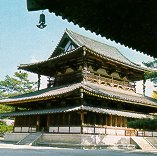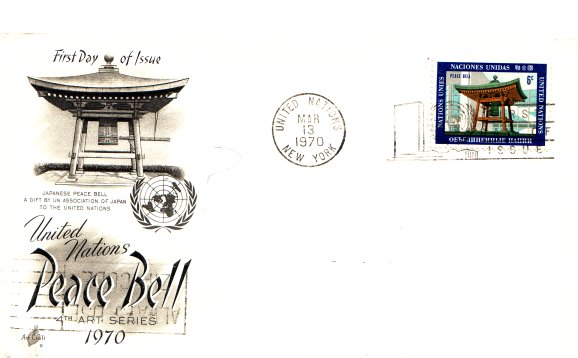
The Asuka Era 552-710 C.E.
The Asuka Era is called as such since the capital of the country was in Asuka district in this period of time.
The Yamato power was restored by Prince Shotoku. This period then saw the first attempts to establish a constitution and a system of official ranks. Since Shotoku promoted Buddhism this period saw a lot of Buddhist temples built. Prince Shotoku began to pattern many Japanese things after their Chinese counterparts. In 603 he began to introduce the Chinese method of bureaucratic rule. In 604 he issued his "Seventeen Article Constitution", establishing the ruler of the country as supreme and a "heavenly Sovereign." Government powers were to be centralized, and all people, including the clan leaders, were to show obedience to the ruler of the country. A 607 diplomatic mission to China referred to Japan for the first time as "The Land of the Rising Sun."
The year 607 also saw the original Horyu-ji temple completed as a result of a vow by emperor Yomei. The building was destroyed by fire in 670 and the present buildings were constructed late in the 7th century. The Horyu-ji pagoda has five stories. This might be because the number 5 is an auspicious number; it also could have been related to the five elements (earth, water, fire, wind, sky). In either case, the pagoda itself has no actual function.

The five-story Pagoda from the Horyu-ji temple.
In the early part of the 6th century the Soga house rose in power, holding important positions in the government. Gradually they became strong enough to intervene in imperial succession and were responsible for the assassination of prince Yamashiro-no-Oe in 645. Prince Naka-no-Oe allied with another noble, Nakatomi-no-Kamatari, and staged a coup de tat which was called "Taika-no-Kaishin.". This was accomplished by assassinating Soga-no-Iruka, the leader of the house of Soga, at a banquet.
Prince Nakano-Oe they took over the government and became Emperor Tenji in 668. Natatomi-no-Kamatari renamed himself Fujiwara-no-Kamatari and his house came to rule the government in the Heian Era. The Taika Reforms followed ideals that had been established by Prince Shotoku. During this period Japanese administration of Korea ended.
Emperor Tenji died in 671 leaving two apparent successors, one his elder son Prince Otomo and the other Prince Oama. Tenji had named Otomo his successor earlier and Oama had retired from the government and became a Buddhist priest. This did not prevent him from making a move for power, though, and he won and Prince Otomo committed suicide. This battle is referred to as the battle of Jinshin (672). Oama became Emperor Tenmu. The Taika Reforms were developed into a code known as the Ritsuryo under Emperor Tenmu and were later improved upon by his grandson, Mommu.
The staple foods of this time period were bulbs, roots and types of millet. Rituals relating to food purity and food offerings began during this time. The introduction of Buddhism had a major influence on the foods used since Buddhists don't eat meat. As trade with China grew new foods began to be imported into Japan. Rice cultivation began and the importance of rice in the diet grew.

Kondo (Golden Hall) from the Asuka era
Particular dates of importance
538-552: Introduction of Buddhism from Korea
572-585 Emperor Bidatsu
585-587: Emperor Yomei
587-592: Emperor Sushun
593-628: Empress Regent Suiko
577-622: Prince Shotoku
585CE: Building of the Horyuji temple in Nara.
587: Victory of the pro-Buddhist Soga faction leads to a more rapid acceptance of Chinese ideas
587: Soga clan achieves ascendancy at court
593: Building of the Temple of Four Heavenly Kings in Osaka. (None of the original buildings exist any more)
600: Chinese and Korean artists and craftsmen settle in Japan.
603: State code passed saying people should revere the Three Precious Things: the Buddha, the Law, and the Priesthood.
604: Prince Shotoku's "Seventeen Article Constitution"; adoption of Chinese calendar
607: Prince Shotoku sends emissaries to China to learn about its arts and culture.
607: Completion of Horyuji temple and hospital in Japan by emperor Yomei. The hospital is the oldest surviving wooden building in the world.
624: As of this year there are 46 Buddhist temples, 816 monks and 565 nuns in Japan
629-641: Emperor Jomei
642-645: Empress Regnant Kogyoku
645: The Soga ruling group is overthrown in a coup and the new era is named the Taika, or "Great Change" era.
645: The Taika Reform abolishes most private land ownership. The Taiho Code of 701 creates various administrative offices and a legal system.
645-654: Emperor Kotoku
655-661: Empress Regnant Saimei (Empress Regnant Kogyoku rethroned)
661-672: Emperor Tenji
663: Loss of Japanese foothold in Korea, largely due to the defeat of the Japanese armada.
672: Emperor Kobun (Kohun?)
672-686: Emperor Temmu
681: Eastern pagoda of Yakashi Temple, Nara, constructed.
686-697: Empress Regnant Jito
697-707: Emperor Mommu
701-702: Codification of Japanese political law into the Taiho, or "Great Treasure", the ritsu, or penal code, and the ryo, or administrative code.
707-715: Empress Regent Gemmei
708: Government mints first copper coins
710: Buddhist monasteries become centers of civilization
710: Establishment of capital at Heijo, later known as Nara

|